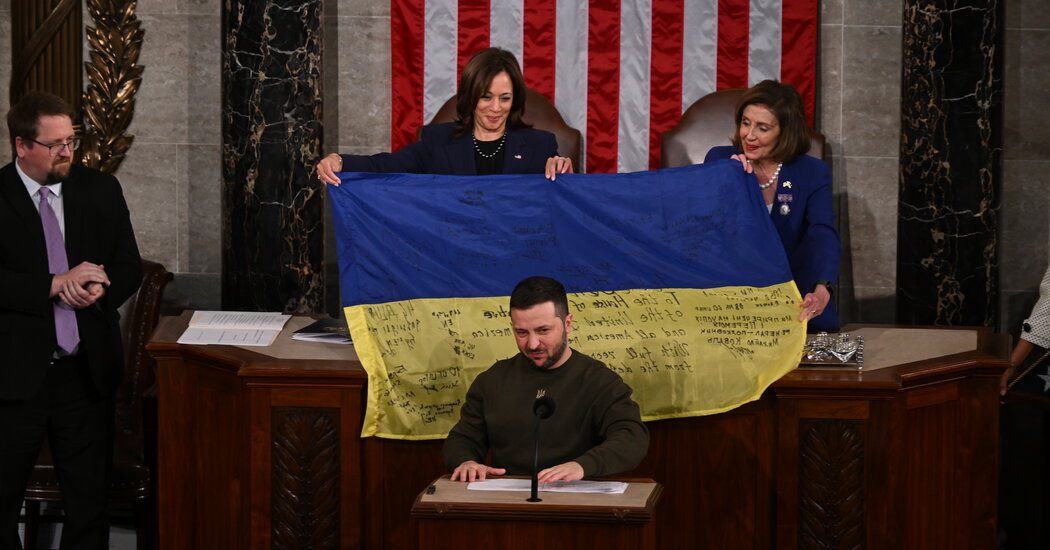
He never donned the political camouflage of a suit.
The olive green sweatshirt, with its little Ukrainian trident embroidered at the neck, cargo pants and boots that President Volodymyr Zelensky of Ukraine wore on his trip to Washington may seem the least important part of the highly choreographed and powerful piece of political theater that was that diplomatic event, but they were also a telling detail: a reminder of what exactly the purpose of the surprise visit had been.
Namely, that despite the fact that it was Mr. Zelensky’s first foreign trip since the Russian invasion of Ukraine began, and despite the fact that Ukraine has defied all odds in holding out for 10 months against an aggressor that was widely expected to roll over the country with ease, the watching world should be on notice: The fight was far from over.
In his wartime uniform, Mr. Zelensky was a constant, living symbol of that battle, no matter the pomp and circumstance that surrounded him.
His D.I.Y. fatigues stood out from the moment he emerged from his diplomatic vehicle on the White House lawn to be greeted by President Biden and the first lady, Jill Biden. They were a stark contrast to the president’s classic navy suit and the first lady’s sky blue coatdress and pumps. They stood out when Mr. Zelensky posed with the president for a photo call in the Oval Office, just in front of a fireplace festooned with Christmas wreaths, and in the joint news conference the two men held afterward, the flags of the United States and Ukraine at their backs.
And they especially stood out in the grand, wood-paneled halls of the Capitol building, where Mr. Zelensky took to the podium to address a joint session of Congress, looking out at a sea of dark suits, occasionally lightened by lawmakers wearing jackets and accessories in the blue and yellow of Ukraine.
“As far as we know, no one’s ever addressed the United States Congress in a sweatshirt before,” Tucker Carlson scoffed later on his Fox News show, comparing Mr. Zelensky to “the manager of a strip club” as well as to Sam Bankman-Fried, the disgraced cryptocurrency financier. (The idea was, perhaps, to suggest that both men eschewed a suit and used people’s money for their own purposes — though that seems a bit of a stretch, since one has been indicted on charges of fraud and the other is fighting for his country.)
The State of the War
Mr. Carlson may have been right about it being a first for the sweatshirt and Congress, but he missed the symbolism behind the choice. And there’s no question it was a choice aforethought.
There was enough time, after all, during his journey overseas, even given its clandestine nature, for Mr. Zelensky to change clothes if he had wanted. And he clearly understands the power of optics. Not just because of his background as an actor, but because of the consistency with which he has played his part in public speeches, addressing his people and his allies via video message from a bunker in Kyiv, Ukraine, most often in an olive green tee ,connecting himself to the men on the ground, giving a human face to the fight. Military garb comes with its own hierarchy and associations. That Mr. Zelensky has chosen the most basic, democratic garments of all to make his own is not an accident.
And that he chose to remain in character for Congress was as much a strategic decision as any deployment, this one targeted to an image-consuming age. To say that he understands part of his job is marketing and branding is not to dismiss his appearance as merely performative, but to acknowledge that he is using every tool at his disposal in service of his goal.
As it happens, Speaker Nancy Pelosi had made her own comparisons regarding Mr. Zelensky’s trip, likening it to Winston Churchill’s 1941 address to Congress, also in December, also in wartime. (The Churchill comparison was a popular one.) But while Mr. Churchill had arrived at the White House with his own symbolic accessories — wearing a naval cap, carrying a walking stick topped by a flashlight as a relic of London’s blackouts — he spoke to Congress in the traditional, stately familiarity of a suit, appealing to the like-minded by looking like-minded.
Mr. Zelensky took a different tack, understanding that he would have painted a different picture of his circumstances had he changed his style, suggesting perhaps that the war had also changed. Instead, he stayed his course.
When, at the end of his speech, Mr. Zelensky handed a Ukrainian flag signed by soldiers fighting on the Donbas front to Ms. Pelosi and Vice President Kamala Harris, and they unfurled it behind his olive green silhouette like a frame, it was the picture of the evening. Odds are, when history is written, it will be the image that remains.
It was impossible not to read in that visual the point the Ukrainian president also made in words: that he was there not as a sovereign leader making nice with a global peer, but as a sovereign leader turned soldier, to reiterate not just to those in the room but to all possible audiences (the people watching at home, skimming the internet, sitting in the Kremlin), that he and the country he represents were fighting not just for themselves, but for the values the Western world holds dear. That they were fighting for everyone, and that it was a fight as much for minds as for land.
The sweatshirt said it all.




